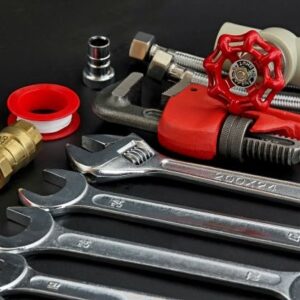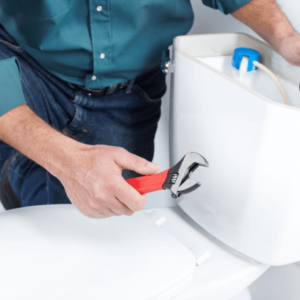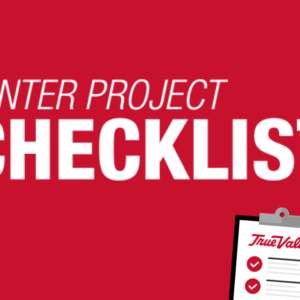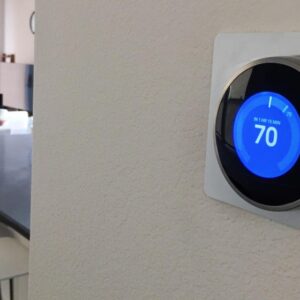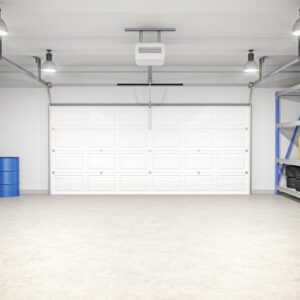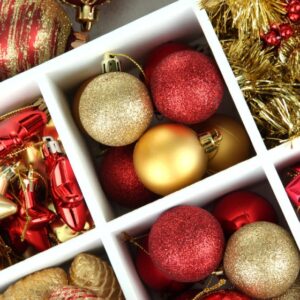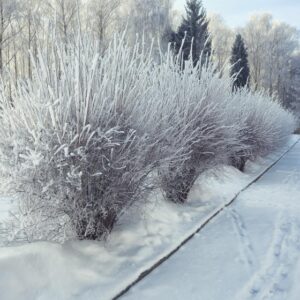Energy costs go up in winter as you try to keep out the seasonal chill. When you add holiday lighting displays to your electric bill, your energy spending can really add up. You can conserve energy and reduce costs by swapping out old light strings with energy-efficient LED holiday lighting. Keep reading to find out more.
Get to Know LED Christmas Lights
Have you ever wondered what LED means? Light-emitting diode (LED) light strings are an energy-efficient alternative to incandescent light strings that save money, glow at lower temperatures and last longer than standard incandescent holiday lights. Here are the details:
- Reduced energy costs – LED holiday lights use 75% to 90% less energy than incandescent lights.
- Increased Safety – LED lights operate at cooler temperatures, reducing the risk of accidental fire. They also use less electricity so many strings can be used safely from the same outlet.
- Last longer – LEDs have an operational life span of roughly 20,000 hours (enough to last for 40 holiday seasons), according to the U.S. Department of Energy.
- More durable – LEDs are more durable and shock-resistant than incandescent bulbs because the bulbs are not made of glass and there are no filaments that can be damaged.
- Longer warranties – Many LED strings come with a minimum 3-year warranty, longer than many standard light string warranties.
- Cool features – LED holiday lights come in a variety of colors, shapes and lengths. Many LED holiday lights are dimmable, change colors or have automatic shut-off and motion control.
Hanging Christmas Lights Outside

Along with a variety of holiday decorating tips, you’ll find a variety of styles and types of both indoor and outdoor LED Christmas lights at your local True Value hardware store. There are string icicle lights for roof edges, net lights for bushes, colored floodlights and rope lights for railings, porches, trees, doors and windows.
Outside, plan out your holiday light installation by first making a dimensioned sketch of the area of the house that you’ll be lighting. With the house sketch and list of available supplies at hand, devise a plan for lights and write up a shopping list. Buy a 16-gauge extension cord with an in-line circuit breaker and multi-outlet plug if you’re stringing many lights. You may need additional standard 16-gauge cords. “Landscape” cords are colored green to make them less visible in the grass and shrubs. Wrap all connections with electrical tape and/or cover them with a plastic bag taped to the cords to seal the ends. If you have an outdoor outlet that has covers that snap over the unused receptacles, replace the cover with a larger “in-use” type, which will protect the receptacle from the weather when it is in use. Also make sure that the receptacle is a GFCI (ground-fault circuit interrupter) type.
Use string lights, regular or icicle-style, to outline the architectural lines of your house. Slip universal-style clips under sidewall siding or the shingles at gable roof edges and snap the wires or lamps into the clips. Use gutter clips or S-hooks to hang strings of lights to the front edge of gutters.
Rather than trying to twist and wrap wires around tree and shrub branches, use reusable clips and/or various sizes of plastic cable ties.
Safety Alerts!
Make sure you stay clear of power lines when you install holiday lights.
If connecting to an inside power source, keep the window or door open slightly so the cord does not get crushed.
Hanging Christmas Lights Inside
Inside, when adding lights to your Christmas tree, for example, work from the inside, close to the tree trunk out towards the tips of the branches. When you reach the tip of a branch, wrap your way back toward the trunk.
Mini lights and C7 Christmas lights are typically used to decorate indoor trees. There are a number of LED options in these styles of lights to choose from. Ask the experts at your local True Value hardware store for assistance in choosing the right bulbs for your tree.
Use holiday lights throughout your home, such as LED rope lights and LED mini-lights along doorways, windows, stair railings and mantels, to add a festive look to your rooms.
Helpful Tips
Use timers to control your holiday lights so they activate only at night.
Consider using fewer lights in your holiday displays to eliminate redundant and unnecessary power use.

Christmas Lights Safety
Follow these safety precautions for your holiday light installation projects. Use only lighting rated for indoor use inside your home. Holiday lights are rated for indoor or outdoor use and must be used in their intended settings. The same goes for extension cords. For outdoor lights, only use heavy-duty extension cords rated for outdoor use.
Each year, check your light strings for fraying, breaks or tears. Before you hang them, check each bulb and the entire wire for any kind of damage. Look specifically for places where bare wires are exposed. If you see extensive damage, the strand needs to be replaced.
Whether you are hanging lights indoors or outdoors, don’t use staples, nails or other sharp objects to hang them. You risk damaging the wire, which can then potentially cause a fire or electrocution. Use insulated holders specifically manufactured for hanging holiday lights. Don’t hang indoor lights near your fireplace.
Be sure your holiday lights are UL-approved. Underwriters Laboratories (UL) evaluates thousands of products each year for safety and assurance. Products that bear the UL mark have passed stringent tests and meet high safety standards. Check the packaging to see if the UL stamp is present. If it is, the product is very safe to use as long as it’s used properly.
Safety Alerts!
Unplug all holiday lights before leaving home or going to bed.
Avoid overloading electrical outlets or extension cords. Use no more than three standard-size sets of lights per single extension cord.
Keep all cords out of the way in high-traffic areas in your home.
Never use electric lights on a metallic tree. The tree can become charged with electricity from faulty wires.
Helpful Tip
To add protection against electric shock, outdoor electric lights and decorations should be plugged into ground-fault circuit interrupter (GFCI) outlets.
Keep your lights in proper working condition by taking outdoor lights down as soon as the holidays are over and storing all lights properly in a storage tote or container. Consider investing in a holiday light storage reel to store your lights. You can also make your own. Save wrapping paper and paper towel tubes to wrap the lights around to keep them from tangling. Store each light string in its own plastic bag or container. When unplugging light strings, always pull the plug from the receptacle by the plug, not the cord. Check the lights for any signs of weakness as you did when you pulled them from storage to hang them. Store the lights in a dry place, preferably in a waterproof storage container and off the floor where they are safe from dampness.
That’s it! Your holiday lights should now be festive and efficient.
Project Shopping List
Here’s what you’ll need to complete this project successfully.

